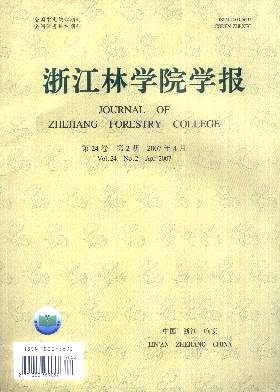| [1] |
WANG Cheng, DONG Bin, PENG Wenjuan, CHEN Lingna, HUANG Hui, YE Xiaokang, ZHU Ming, LÜ Dian, NI Yanhua, ZHAO Kangkang, ZHANG Shuangshuang.
Influence of land-use change on the crane habitat and population in Shengjin Lake Wetland
. Journal of Zhejiang A&F University,
2018, 35(3): 511-518.
doi: 10.11833/j.issn.2095-0756.2018.03.016
|
| [2] |
YANG Xiaolan, GONG Hede.
Seed predation by rodents in northwest Yunnan Province
. Journal of Zhejiang A&F University,
2015, 32(3): 440-445.
doi: 10.11833/j.issn.2095-0756.2015.03.017
|
| [3] |
ZHENG Fangdong, BAO Qimin, LIN Lisi, ZHANG Shusheng, LIU Xi.
Origin and evolution of Xerinae
. Journal of Zhejiang A&F University,
2015, 32(5): 797-802.
doi: 10.11833/j.issn.2095-0756.2015.05.021
|
| [4] |
GONG Hede, YAN Teng, PENG Yihang, ZHENG Li, MA Yuewei.
Seedling growth of Symplocos ramosissima with manually controlled experimental conditions in the Ailaoshan Mountains, Yunnan Province
. Journal of Zhejiang A&F University,
2015, 32(2): 237-243.
doi: 10.11833/j.issn.2095-0756.2015.02.010
|
| [5] |
ZHENG Yanxia.
Winter habitat selection for elliot's pheasant in Guanshan National Nature Reserve,Jiangxi Province
. Journal of Zhejiang A&F University,
2014, 31(1): 89-96.
doi: 10.11833/j.issn.2095-0756.2014.01.014
|
| [6] |
XU Wenhui, YUE Xiaolei, GAO Peng, XIA Shujuan.
Potential ecological habitat of Muntiacus crinifrons within National Nature Reserve of Mount Tianmu,Zhejiang Province
. Journal of Zhejiang A&F University,
2013, 30(6): 896-903.
doi: 10.11833/j.issn.2095-0756.2013.06.014
|
| [7] |
YU Yun-wei, YING Ye-qing, REN Li-ping, HU Jia-fu, ZHAO A-yong.
Community structure and biodiversity of soil animals in bamboo stands of Lin’an,Zhejiang
. Journal of Zhejiang A&F University,
2012, 29(4): 581-587.
doi: 10.11833/j.issn.2095-0756.2012.04.015
|
| [8] |
ZHU Xi, CAO Wei-bin, WANG Jun.
Mammalian fauna and distribution of Putuoshan Island in Zhoushan
. Journal of Zhejiang A&F University,
2010, 27(1): 110-115.
doi: 10.11833/j.issn.2095-0756.2010.01.018
|
| [9] |
ZHU Xi, WANG Qing-liang, ZHAN Yin-bo, HAN Pu, JIANG Hong-yun, ZHOU Wen, HE Yu-bo.
Fauna and distribution of amphibian and reptile on Putuoshan Island,Zhejiang
. Journal of Zhejiang A&F University,
2009, 26(5): 708-713.
|
| [10] |
LI Ning, ZHOU Wei, YANG Yan-ying, ZHANG Qing, LIU Zhao.
Microscopic analysis on winter plant food of Syrmaticus humiae (Hume’s pheasant) in Dazhongshan,Yunnan
. Journal of Zhejiang A&F University,
2009, 26(3): 363-367.
|
| [11] |
ZHU Gui-shou, DING Liang-dong, YU Gen-lian, ZHOU Xiao-li.
Wildlife domestication and propagation industry in Zhejiang Province
. Journal of Zhejiang A&F University,
2008, 25(1): 109-113.
|
| [12] |
SHAO Ji-feng, LU Qing-bin, JIN Jing, YOU Wei-yun, YU Jiang-ao.
Winter feeding site selection of ring-necked pheasants in Mount Qingliangfeng
. Journal of Zhejiang A&F University,
2008, 25(4): 507-512.
|
| [13] |
ZHANG Zong, LIANG Nan-nan, GUO Yu-dong, ZHAO Jun.
Diversity of landscape architecture approach in city birds protection
. Journal of Zhejiang A&F University,
2007, 24(4): 511-515.
|
| [14] |
ZHUXi, XUMin-yu, GE Ying-chuan, CHENZhong-yi, LI Chun-yao.
A vifauna in Mount Longwang Nature Reserve of Zhejiang
. Journal of Zhejiang A&F University,
2007, 24(1): 77-85.
|
| [15] |
HUZhong-jun, WANG Yu, XUEWen-jie, JIANG Hai-rui, XUHong-fa.
Population density of Moschus berezovskii in Zibaishan Nature Reserve of Feng County, Shaanxi
. Journal of Zhejiang A&F University,
2007, 24(1): 65-71.
|
| [16] |
KUANG Fen-liang, LIU Ning, CANGJUE Zhuoma, LI Jian-chuan, YANG Le, LI Fu-xiu.
Diurnal time-activity budgets of Grus nigricollis for the pre-laying phase in northern Tibet
. Journal of Zhejiang A&F University,
2007, 24(6): 686-691.
|
| [17] |
PANShi-xiu, MEN Xiu-xiang, FENG Jin-chao, ZHOUYi-jun, XUHong-fa.
A review of studies on habitat selection by small and solitary forest ruminants
. Journal of Zhejiang A&F University,
2007, 24(3): 357-362.
|
| [18] |
YAN Shao-jun, ZHU Xi, YU Yi-wu.
Construction techniques for the city heronries in Central China
. Journal of Zhejiang A&F University,
2006, 23(6): 697-700.
|
| [19] |
HE Jia-fei, ZHOU Wei, LI Ming-hui.
Preliminary observation on reproductive ecology of Kaloula verrucosa
. Journal of Zhejiang A&F University,
2006, 23(3): 311-315.
|
| [20] |
LI Wei, ZHOU Wei, JI De, ZHANG Ren-gong.
Habitat use of Syrmaticus humiae in Nanhua Part of Ailaoshan National Nature Reserve in spring
. Journal of Zhejiang A&F University,
2006, 23(2): 153-158.
|









 DownLoad:
DownLoad: